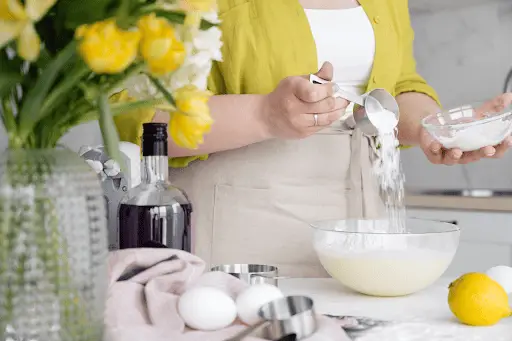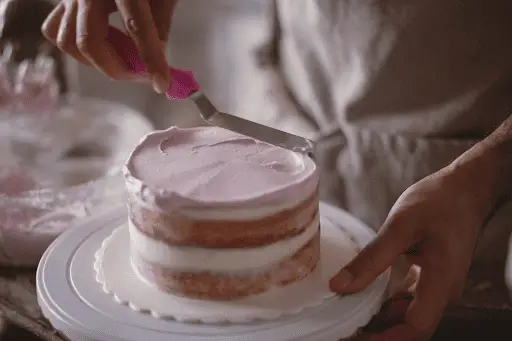Have you ever found yourself in the middle of baking a recipe when you suddenly noticed the recipe calls for specialty flour like cake flour?
Many amateur bakers start baking assuming all flour is the same, but that’s not true. While many recipes do well with all-purpose flour, there are some recipes where cake flour will get you better results.
While in some cases, all-purpose flour and cake flour can be used interchangeably, you will see differences in the texture and consistency of your final product when swapping one for the other. As a baker, you may find yourself in scenarios where you want to use cake flour but only have all-purpose flour available. Thankfully, cake flour substitute is something simple enough to make on the fly at home, using ingredients you already have in your cupboard.
Daisy Flour prides itself on providing baking expertise to bakers who need it. We love providing the reviews, recommendations, and baking tips people need to take their baking to the next level. In this guide, we will go over everything you need to know about using cake flour and making cake flour substitutes at home.
Let’s get started!
What Is Cake Flour and Why Substitute?

Before we get into the cake flour substitute recipes, we first need to understand what cake flour is and why it’s worth your time to use it in place of all-purpose flour.
Understanding Cake Flour
Cake flour is a specific type of flour that is commonly used when baking cakes. The main characteristic that sets cake flour apart is its protein content. While all-purpose flour can have a protein level between 10-12%, cake flour is around 5-8%.
This low protein content helps your baked goods come out with a much more delicate, soft texture. This is because of how cake flour’s protein levels impact gluten formation. Low protein flour yields less gluten formation while baking, producing a soft and fluffy texture. This is the texture bakers are looking for when making things like cake!
Characteristics and Purpose in Baking
As we mentioned above, the defining characteristic of cake flour is its low protein content. It is also a more finely milled flour, giving it a softer and silkier consistency when compared to other kinds of baking flour.
These characteristics are what make this flour suited to cake baking. It’s the ideal flour to use when trying to bake anything where you are looking for a moist, fluffy, soft texture.
While this flour suits cake baking and making delicate baked goods, it is not ideal for heartier things like bread. Bread is a baked good that benefits from bread flour or all-purpose flour, as it will give your final product a stronger structure.
Reasons to Make a Cake Flour Substitute
There are many good reasons why someone might make substitute cake flour at home.
Most bakers choose to make substitute cake flour because of the lack of it at home. You may only have plain flour in your pantry while baking, with no time to go to the grocery store to buy real cake flour. In these cakes, homemade cake flour substitutes can step in to save the day.
Dietary Restrictions or Preferences
Another reason why people like making an easy cake flour substitute at home is because of certain dietary restrictions they might have. For example, if you live gluten-free, you can make a substitute cake flour recipe with an alternative flour that suits your diet.
Homemade Cake Flour Substitute Recipes

If you’re looking for an easy cake flour substitute to make at home, we have you covered! These recipes work by incorporating an additive to all-purpose flour that lowers the overall protein content, mimicking the effects of real cake flour.
Recipe 1: All-Purpose Flour and Cornstarch
Adding cornstarch to all-purpose flour is an easy way to make cake flour substitute at home. Here’s how to do it:
Ingredients and Measurements
For this recipe, you’ll need:
- 1 cup all-purpose flour
- 2 tablespoons of cornstarch
Mixing Instructions
Step 1: First, measure out 1 cup of all-purpose flour.
Step 2: Then, using your tablespoon, remove 2 tablespoons of all-purpose flour from your 1-cup all-purpose flour measurement.
Step 3: Once 2 tablespoons of flour are removed, replace with two tablespoons of cornstarch.
Step 4: Mix to combine, and you’re done! You now have 1 cup of cake flour for your cake recipe.
Tips for Best Results
For best results, we highly recommend you sift the mixture once combined to ensure flour and cornstarch is fully incorporated. You can do it with a cake sifter or sieve.
Recipe 2: All-Purpose Flour and Baking Powder
You can also use baking powder to create cake flour substitutes at home.
Ingredients and Measurements
For this recipe, you’ll need the following:
- 1 cup all-purpose flour
- 2 tablespoons baking powder
Mixing Instructions
Step 1: To start, measure out 1 cup of all-purpose flour.
Step 2: Once measured, add two teaspoons of baking powder.
Step 3: Mix well to combine, and you’re done!
Tips for Best Results
Like the recipe above, we recommend sifting this mixture to ensure everything is fully combined. You can also add a ¼ teaspoon of salt for flavor.
Recipe 3: All-Purpose Flour and White Vinegar
You can make homemade cake flour if you have white vinegar and all-purpose flour at home. Here’s how to get it done:
Ingredients and Measurements
For this recipe, you’ll need:
- 1 cup all-purpose flour
- 1 tablespoon white vinegar
Mixing Instructions
Step 1: First, measure out one cup of all-purpose flour.
Step 2: Next, add 1 tablespoon of white vinegar to the all-purpose flour.
Step 3: Mix until well combined, then use as needed.
Tips for Best Results
Mixing this one thoroughly is important to ensure vinegar is evenly distributed throughout the flour. Again, we recommend a sifter here.
How to Use the Cake Flour Substitute

We have a few helpful tips you should keep in mind when using any kind of cake flour substitute.
Proper Incorporation in Baking Recipes
The most important thing to remember when making and using cake flour substitute is its incorporation into your recipe. This is important both when determining the measurements in substitute recipes and the techniques you use to incorporate your mixes together.
Measuring and Sifting Techniques
When making cake flour substitutes, measurements are extremely important. It should always be a one-to-one replacement for cake flour when determining the amounts needed for a recipe.
We also recommend that when incorporating your ingredients, you do so gently. If mixing by hand, overmixing can cause gluten to develop, leading to a denser final product. Instead of hand mixing, we recommend using a sieve or sifter to sift together ingredients when making cake flour.
Adjusting Liquid Content if Needed
It is also important to adjust the liquid content of recipes when using a homemade cake flour substitute. Cake flour tends to absorb less liquid than all-purpose flour, meaning your batter consistency might change.
If your mixture is too dry or thick, you can add liquid like water or milk. Add gradually and stir gently until you reach your desired consistency.
Frequently Asked Questions (FAQs)
If you still have more questions about cake flour substitutes, we have the answers you’re looking for. Here are the most frequently asked questions about cake flour substitutes.
Can I use whole wheat flour as a substitute?
It is not recommended to use wheat flour when making cake flour substitutes. Wheat flour has a high protein content, even higher than all-purpose flour, making it better suited to baked goods that need a denser, coarser structure.
How does cake flour substitute affect the texture of the cake?
Cake flour substitute will make cakes lighter and more airy, but they may not come out with the same texture you’d achieve with real cake flour.
These substitutes do really well in mimicking the low protein content of cake flour, but it is not exact. You may find cakes slightly denser or with a different crumb consistency when using cake flour substitute instead of cake flour.
Can I store cake flour substitute for later use?
For best results, we recommend using a cake flour substitute immediately after you prepare it. Most people don’t realize this, but flour can go bad over time.
However, if you do want to store it, do so in an airtight container, stored somewhere cool and dry. We recommend labeling and dating the mixture and using it within a month. Keep in mind, the flour may lose some effectiveness after being stored for some time.
Give Cake Flour Substitute a Try

If you need a last-minute solution for a lack of cake flour, a cake flour substitute can be an incredibly handy solution! Easily made with ingredients in most baker’s pantries, cake flour substitute is a great way to create cakes and pastries with the light and airy texture you’ve been looking for.
A soft baked good like a fluffy vanilla cake becomes next level when made with cake flour. Cake flour is the secret behind airy and light textures, thanks to its low protein content compared to all-purpose flour. We highly recommend all home bakers give cake flour a go and experiment with cake flour substitutes when making their next cake.
We at Daisy Flour have tons of resources for bakers, from product reviews to baking tips and more! Click here to explore more of our baking content.
